บทความ
Redstone บล็อกเชนแบบ Oracle ที่สามารถทำงานได้แบบ Cross-Chain รองรับมากกว่า 70 เชน
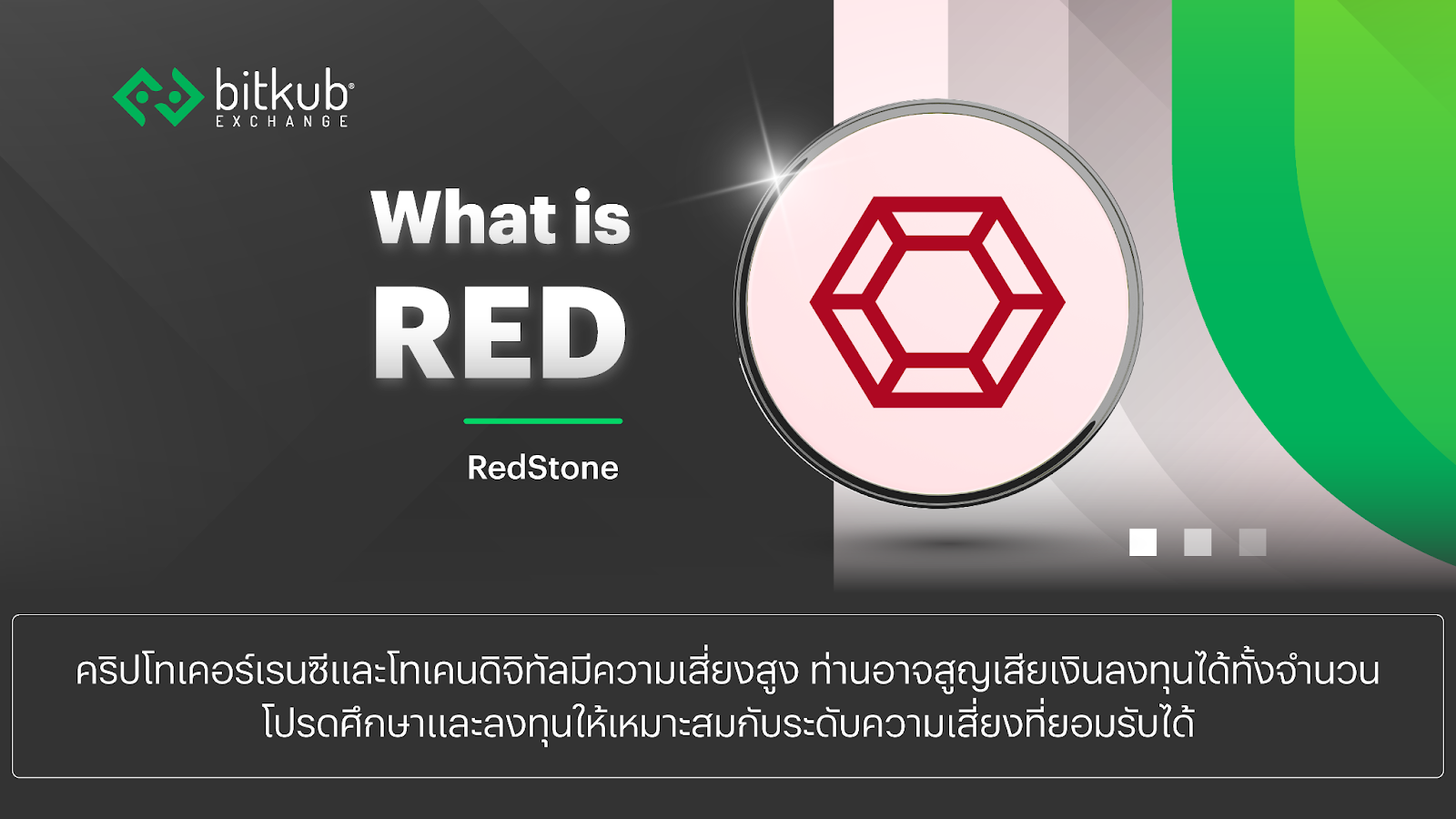
ในโลกอันซับซ้อนของการเงินแบบกระจายศูนย์ (DeFi) ความท้าทายสำคัญยังคงอยู่ที่การนำข้อมูลจากโลกแห่งความเป็นจริงมาสู่บล็อกเชนอย่างปลอดภัยและมีประสิทธิภาพ โดย RedStone (RED) เครือข่าย Oracle ที่จะเข้ามาเปลี่ยนแปลงในการแก้ปัญหา “Oracle Problem” นี้โดยเฉพาะ ด้วยแนวทางแบบโมดูลาร์ (Modular) ที่แปลกใหม่ โดย RedStone วางตำแหน่งตัวเองในฐานะโครงสร้างพื้นฐานที่สำคัญสำหรับ dApp ยุคถัดไป บทความนี้จะเจาะลึกถึงเทคโนโลยีหลัก คุณสมบัติเด่น ของ RedStone สำหรับผู้ที่หลงใหลในโลกคริปโตโดยเฉพาะ
Redstone (RED) คืออะไร?
หัวใจหลักของ RedStone คือ เครือข่าย Oracle ที่ให้บริการป้อนข้อมูล (Data Feeds) แก่เครือข่ายบล็อกเชนกว่า 50 แห่ง ซึ่งรวมถึงการเป็นบล็อกเชนที่เข้ากันได้กับ EVM และบล็อกเชนที่ไม่ใช่ EVM สิ่งที่ทำให้ RedStone แตกต่างคือสถาปัตยกรรมแบบโมดูลาร์ที่ล้ำสมัย แทนที่จะส่งข้อมูลเข้าสู่บล็อกเชนอย่างต่อเนื่องเหมือน Oracle แบบดั้งเดิมซึ่งมีค่าแก๊สสูงแต่ RedStone จะจัดเก็บข้อมูลไว้บนโซลูชันการจัดเก็บข้อมูลแบบกระจายศูนย์อย่าง Arweave และจะส่งข้อมูลนั้นมายัง on-chain ก็ต่อเมื่อ dApp ร้องขอเท่านั้น
สิ่งนี้เกิดขึ้นได้ผ่านโมเดลการส่งข้อมูลสามรูปแบบที่แตกต่างกัน ซึ่งมอบความยืดหยุ่นที่เหนือชั้นให้กับนักพัฒนาหลายหลายได้แก่
— RedStone Core (Pull Model): โมเดลแบบออนดีมานด์นี้ช่วยให้ dApp สามารถ “ดึง” ข้อมูลจากที่จัดเก็บนอกเชน (off-chain) และรวมไว้ในธุรกรรมเดียวได้ ซึ่งช่วยลดต้นทุนได้อย่างมาก
— RedStone Classic (Push Model): สำหรับแอปพลิเคชันที่ต้องการข้อมูลที่พร้อมใช้งานตลอดเวลา โมเดลนี้จะ “ผลัก” ข้อมูลไปยังบล็อกเชนตามช่วงเวลาที่กำหนด
— RedStone X (Hybrid Model): เป็นการผสมผสานข้อดีของทั้งสองโมเดลเข้าด้วยกัน เพื่อนำเสนอโซลูชันการส่งข้อมูลที่ยืดหยุ่นสำหรับกรณีการใช้งานที่หลากหลาย
จุดเด่นของ Redstone มีอะไรบ้าง?
RedStone โดดเด่นด้วยการทำงานแบบ Multi-Chain ที่นำมาสู่คุณสมบัติโดดเด่นอื่นๆ อีกหลายประการสำหรับนักพัฒนา ได้แก่
— การประหยัดค่าแก๊ส (Gas Optimization): โมเดลการส่งข้อมูลแบบออนดีมานด์ช่วยประหยัดค่าธรรมเนียมการทำธุรกรรมได้อย่างมหาศาล ซึ่งเป็นปัจจัยสำคัญสำหรับ dApp ที่ทำงานบนเครือข่ายที่มีการใช้งานสูง
— การทำงานร่วมกันข้ามเชน (Cross-Chain Interoperability): การออกแบบแบบโมดูลาร์ของ RedStone ช่วยให้สามารถทำงานร่วมกับระบบนิเวศบล็อกเชนที่หลากหลายได้อย่างราบรื่น โดยไม่จำเป็นต้องปรับใช้โค้ดแบบกำหนดเองสำหรับแต่ละเชน
— รองรับสินทรัพย์เฉพาะกลุ่ม (Support for Niche Assets): RedStone มีความโดดเด่นในการให้บริการราคาที่น่าเชื่อถือสำหรับสินทรัพย์ประเภท Long-tail และสินทรัพย์ที่สร้างผลตอบแทนได้ เช่น Liquid Staking Tokens (LSTs) และ Liquid Restaking Tokens (LRTs) ซึ่งมักไม่ได้รับการสนับสนุนจาก Oracle แบบดั้งเดิม
— ความปลอดภัยขั้นสูง (Enhanced Security): ความสมบูรณ์ของข้อมูลได้รับการรับรองผ่านการลงนามด้วยการเข้ารหัสโดยเครือข่ายผู้ให้บริการข้อมูล และยังมีความปลอดภัยเพิ่มเติมจากการผสานรวมกับ Actively Validated Service (AVS) ของ EigenLayer ซึ่งเป็นการยืมความปลอดภัยทางเศรษฐกิจจาก Ether ที่ถูก Stake ไว้

ภาพแสดงลักษณะของการส่งข้อมูลมายังบล็อกเชนของ RedStone ที่มา RedStone Doc
โดย RedStone ได้รับข้อมูลราคาจากแหล่งข้อมูลกว่า 150 แห่ง ซึ่งรวมถึงตลาดแลกเปลี่ยนแบบรวมศูนย์ (centralized exchanges) และตลาดแลกเปลี่ยนแบบกระจายอำนาจ (decentralized exchanges) อย่าง Uniswap และผู้รวบรวมข้อมูล (aggregators) เช่น CoinMarketCap จากนั้นข้อมูลเหล่านี้จะถูกรวบรวมโดยโหนด (nodes) อิสระที่ดำเนินการโดยผู้ให้บริการข้อมูล (data providers) เพื่อรับประกันความแม่นยำของราคา โหนดเหล่านี้ใช้วิธีการคำนวณที่หลากหลาย เช่น ค่ามัธยฐาน (median), ราคาเฉลี่ยถ่วงน้ำหนักตามเวลา (TWAP) และราคาเฉลี่ยถ่วงน้ำหนักตามสภาพคล่อง (LWAP) ซึ่งจะพิจารณาปัจจัยต่างๆ เช่น ปริมาณสภาพคล่องและราคาเฉลี่ยในช่วงเวลาที่กำหนด
ผู้อยู่เบื้องหลัง Redstone

Jakub Wojciechowski — เป็นผู้ก่อตั้ง และดํารงตําแหน่งเป็น CEO ของ Redstone โดยเขาได้จบการศึกษามาจากมหาวิทยาลัย Warsaw University of Technology ทางด้าน วิทยาการคอมพิวเตอร์ ในก่อนหน้าที่ Jakub จะมาดํารงตําแหน่งที่ Redstone เขาเคยเป็น Chief Tehcnology Officer (CTO) และเป็นผู้ร่วมก่อตั้งบริษัท Alice SI
Marcin Kazmierczak — สำเร็จการศึกษาจากโรงเรียนเศรษฐศาสตร์วอร์ซอ (Warsaw School of Economics) ในปี 2020 โดยมีความเชี่ยวชาญด้าน e-business และต่อมาได้ศึกษาต่อหลักสูตร MBA ที่มหาวิทยาลัยแห่งชาติการเมืองในไทเป และได้มีวิทยานิพนธ์ของเขาในหัวข้อเกี่ยวกับ “เทคโนโลยีบล็อกเชน: การอธิบายอย่างละเอียดและกรณีการใช้งานในเชิงธุรกิจ”
โทเคน RED คืออะไร?
RED Utility ของเครือข่าย RedStone โดยมีบทบาทหลักในการ กำกับดูแล (governance) โปรโตคอล ซึ่งหมายความว่าผู้ถือโทเคนสามารถมีสิทธิ์เสนอและลงคะแนนเสียงในประเด็นสำคัญ เช่น การปรับพารามิเตอร์ของตลาด, การเพิ่มหรือลบสินทรัพย์ที่รองรับ, รวมถึงการเปลี่ยนแปลงโครงสร้างรางวัลหรือกลไกในระบบ
RED หน้าที่หลักในการรับประกันความสมบูรณ์และความน่าเชื่อถือของข้อมูลที่ถูกส่งเข้ามา ผู้ให้บริการข้อมูลจะต้องทำการ Stake โทเคน RED ไว้เป็นหลักประกัน ซึ่งเป็นแรงจูงใจทางเศรษฐกิจที่ทำให้แน่ใจว่าผู้ให้บริการจะดำเนินการอย่างซื่อสัตย์ เพราะพฤติกรรมที่เป็นอันตรายใดๆ จะส่งผลให้โทเคนที่ Stake ไว้ถูกยึด (Slashing)
เพื่อเป็นการตอบแทนบทบาทสำคัญในการรักษาความปลอดภัยของเครือข่าย ผู้ที่ทำการ Stake จะได้รับรางวัลเป็นส่วนแบ่งของค่าธรรมเนียมที่สร้างขึ้นโดยโปรโตคอล ที่สำคัญคือ รางวัลเหล่านี้จะจ่ายเป็นสกุลเงินคริปโตชั้นนำอย่าง ETH, BTC และ USDC ซึ่งสร้างผลตอบแทนที่มั่นคงและน่าดึงดูดใจสำหรับผู้เข้าร่วม
การกระจายของเหรียญ RED

ข้อมูลจากเว็บไซต์ CoinMarketCap และ Redstone Distribution ณ วันที่ 8 มิ.ย. 2025 ระบุว่าโทเคน RED มี Total supply ทั้งหมดอยู่ที่ 1,000,000,000 RED และมี Circulating supply อยู่ที่ 280,000,000 RED
โทเคน RED มีการแจกจ่ายดังนี้:
— 10.00% — การพัฒนาโปรโตคอล
— 24.30% — Ecosystem และผู้ให้บริการข้อมูล
— 4.00% — Binance Launchpool
— 10.00% — ชุมชนและช่วงการเริ่มต้น
— 48.30% — การเติบโตของชุมชน
— 20.00% — ผู้ที่มีส่วนร่วมหลัก
— 31.70% — ผู้สนับสนุนรุ่นแรก
การจัดสรรเชิงกลยุทธ์นี้ ควบคู่ไปกับกำหนดการทยอยปลดล็อกโทเคนที่ชัดเจน ตอกย้ำถึงความมุ่งมั่นของ RedStone ในการสร้างเครือข่าย Oracle ที่ยั่งยืนและขับเคลื่อนโดยชุมชน ซึ่งพร้อมที่จะกลายเป็นรากฐานที่สำคัญของอนาคตแบบกระจายศูนย์
ข้อมูลน่าสนใจด้านราคาของ RED
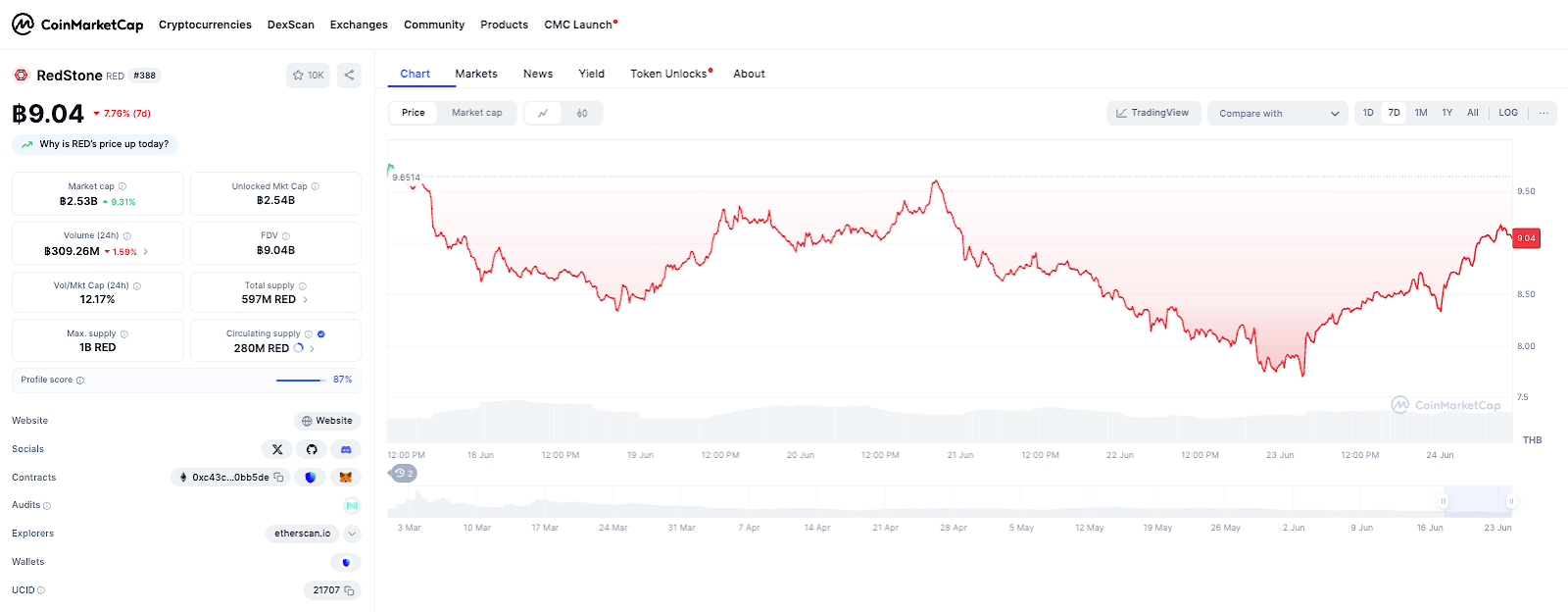
ข้อมูลจากเว็บไซต์ Coinmarketcap เมื่อวันที่ 24 มิ.ย. 2025 เหรียญ RED มีมูลค่าตามราคาตลาด (Market cap) ที่ 77,344,418.3 ดอลลาร์สหรัฐฯ หรือ 2,531,512,703.26 บาท
ณ เวลาที่เขียนบทความนี้ เหรียญ RED ซื้อขายกันอยู่ที่ราคาประมาณ 0.2762 ดอลลาร์ หรือประมาณ 9.04
บาทต่อ 1 RED โดย RED เคยทำราคาสูงสุด (All-time high) ที่ 1.46 ดอลลาร์ หรือประมาณ 47.68 บาท ต่อ 1 RED เมื่อวันที่ 3 มีนาคม 2025
ที่มา: redstone docs, iqwiki Marcin, redstone finance
— — — — — — — — — — — — — — — — —

หากคุณยังเป็นมือใหม่ ค้นหาข้อมูลเพิ่มเติมได้ในบทความ “แหล่งความรู้ มือใหม่หัดเทรดคริปโต เริ่มต้นที่นี่” แล้วมาเริ่มต้นเทรดได้วันนี้ที่ Bitkub Exchange → คลิกสมัครเลย
— — — — — — — — — — — — — — — — —
- คริปโทเคอร์เรนซีและโทเคนดิจิทัลมีความเสี่ยงสูง ท่านอาจสูญเสียเงินลงทุนได้ทั้งจํานวน โปรดศึกษาและลงทุนให้เหมาะสมกับระดับความเสี่ยงที่ยอมรับได้
- ผลตอบแทนของสินทรัพย์ดิจิทัลในอดีตหรือผลการดําเนินงานในอดีต มิได้เป็นสิ่งยืนยันถึงผลตอบแทน ของสินทรัพย์ดิจิทัลหรือผลการดําเนินงานในอนาคต
— — — — — — — — — — — — — — — — —
Redstone: The Cross-Chain Oracle Supporting Over 70 Blockchains
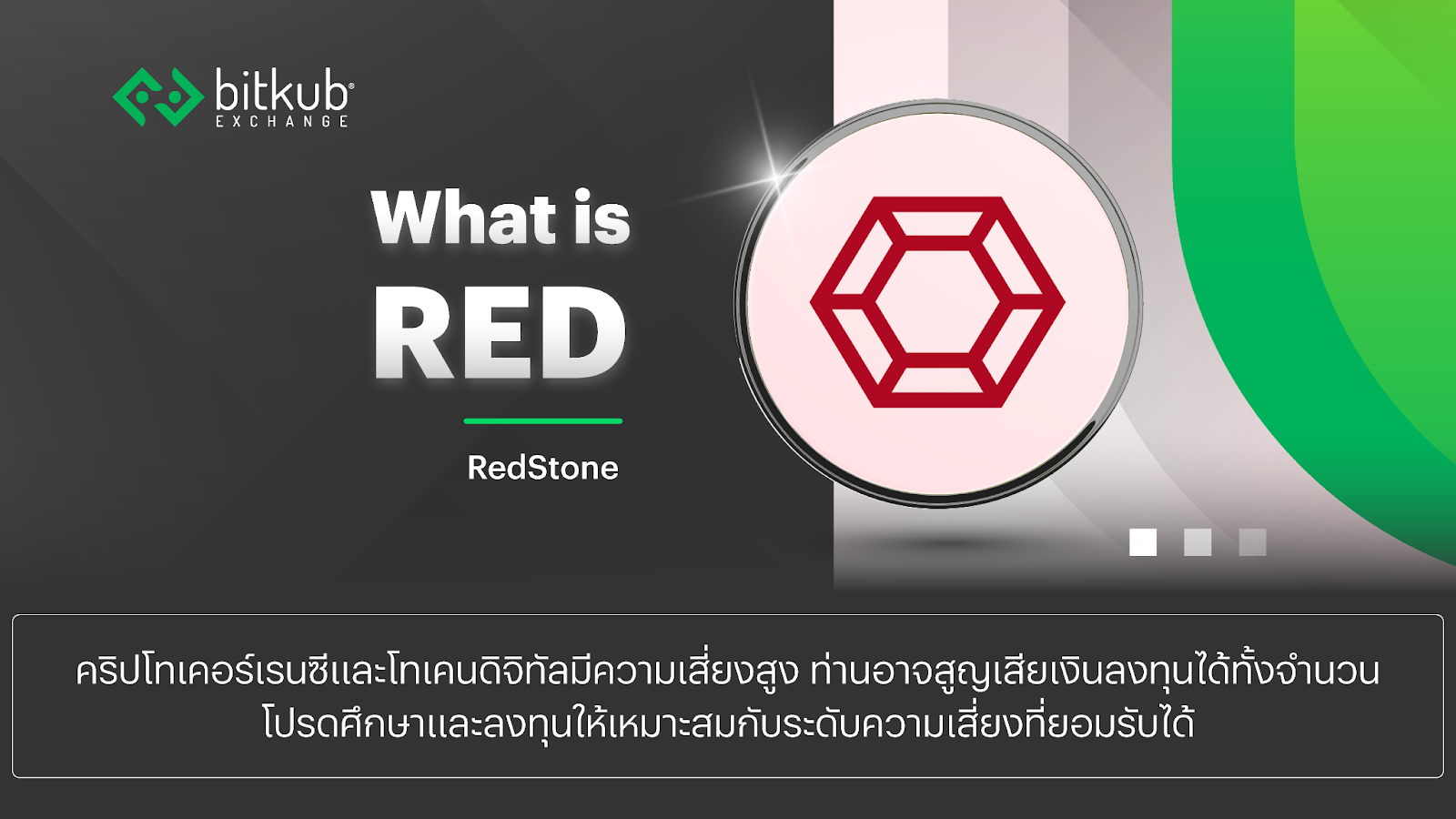
In the intricate world of decentralized finance (DeFi), the secure and efficient delivery of real-world data to blockchains remains a critical challenge. Enter RedStone (RED), a revolutionary oracle network engineered to address this “oracle problem” with a novel modular approach, positioning itself as a vital infrastructure layer for the next generation of dApps. This article explores the core technology, standout features, and tokenomics of RedStone for the discerning cryptocurrency enthusiast.
Deconstructing the Technology: A Modular and Gas-Conscious Design
At its heart, RedStone is an oracle network that provides data feeds to over 50 blockchain networks, including both EVM and non-EVM chains. What sets RedStone apart is its innovative modular architecture. Unlike traditional oracles that continuously push data on-chain, incurring significant gas fees, RedStone stores data on the decentralized storage solution Arweave and delivers it on-chain only when requested by a dApp.
This is made possible through three distinct data delivery models, offering developers unparalleled flexibility:
— RedStone Core (Pull Model): This on-demand model allows dApps to “pull” data from the off-chain storage and include it in a transaction, significantly reducing costs.
— RedStone Classic (Push Model): For applications requiring constant data availability, this model “pushes” data to the blockchain at regular intervals.
— RedStone X (Hybrid Model): Combining the best of both worlds, this model caters to a wide range of use cases by offering a flexible data delivery solution.
Highlight Features: Tailored for a Multi-Chain World
RedStone’s design philosophy translates into several key features that make it a compelling choice for developers:
— Gas Optimization: The on-demand data delivery models lead to substantial savings on transaction fees, a crucial factor for dApps operating on congested networks.
— Cross-Chain Interoperability: RedStone’s modular design enables seamless integration with a diverse array of blockchain ecosystems without the need for custom deployments for each chain.
— Support for Niche Assets: RedStone excels in providing reliable price feeds for long-tail and yield-bearing assets, such as Liquid Staking Tokens (LSTs) and Liquid Restaking Tokens (LRTs), which are often underserved by traditional oracles.
— Enhanced Security: Data integrity is ensured through cryptographic signing by a network of data providers and is further secured through an integration with EigenLayer’s Actively Validated Service (AVS), leveraging the economic security of staked Ether.

Image illustrating the data flow to the RedStone blockchain. Source: RedStone Doc
RedStone receives price data from over 150 sources, including centralized exchanges, decentralized exchanges such as Uniswap, and aggregators like CoinMarketCap. This data is then aggregated by independent nodes operated by data providers.
To ensure price accuracy, these nodes use a variety of calculation methods, such as the median, time-weighted average price (TWAP), and liquidity-weighted average price (LWAP). These methods consider factors like the amount of liquidity and average prices over specific timeframes.
The Team Behind Redstone
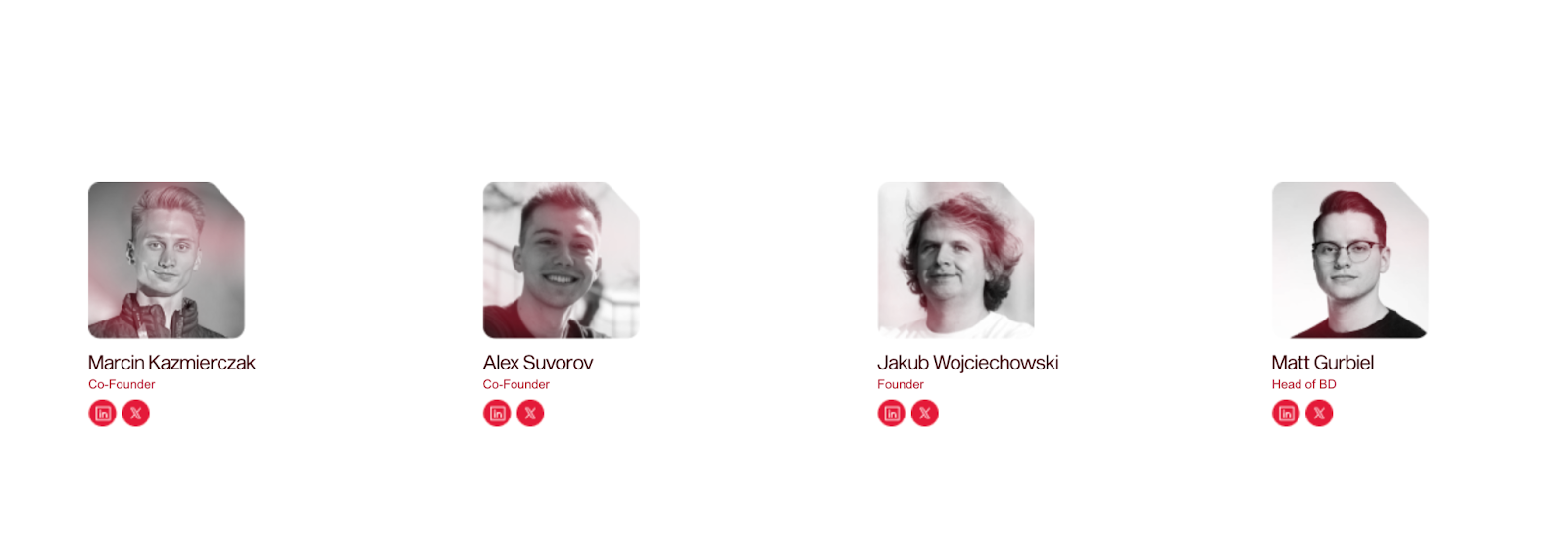
Jakub Wojciechowski — Founder and CEO of Redstone. He graduated from the Warsaw University of Technology with a degree in Computer Science. Before his position at Redstone, Jakub was the Chief Technology Officer (CTO) and co-founder of Alice SI.
Marcin Kazmierczak — Graduated from the Warsaw School of Economics in 2020 with a specialization in e-business. He later pursued an MBA at National Chengchi University in Taipei, where he wrote his thesis on the topic: “Blockchain Technology: A Detailed Explanation and Business Use Cases.”
The RED Token: The Lifeblood of the Ecosystem
The native utility token of the RedStone network is RED. Its primary function is to ensure the integrity and reliability of the data provided. Data providers are required to stake RED tokens as a form of collateral. This economic incentive ensures that providers act honestly, as any malicious behavior would result in the slashing of their staked tokens.
In return for their crucial role in securing the network, stakers are rewarded with a share of the fees generated by the protocol. Notably, these rewards are paid out in prominent cryptocurrencies like ETH, BTC, and USDC, providing a stable and attractive yield for participants. The RED token is also envisioned to play a role in the future governance of the RedStone protocol.
Token Allocation and Tokenomics: A Community-Centric Approach
RedStone’s tokenomics are designed to foster a robust and decentralized ecosystem. The total supply of RED tokens is allocated across several key areas:
— Ecosystem & Data Providers (24.3%): A significant portion is dedicated to incentivizing data providers and fostering the growth of the RedStone ecosystem through grants and other initiatives.
— Early Backers (31.7%): To reward the initial supporters who were instrumental in the project’s development.
— Core Contributors (20%): Allocated to the team and key contributors with a vesting schedule to align long-term interests.
— Protocol Development (10%): To ensure the continued innovation and enhancement of the RedStone protocol.
— Community & Genesis (10%): A substantial allocation for community airdrops and other engagement programs to reward early and active users.
— Binance Launchpool (4%): To facilitate broader distribution and access to the RED token.
This strategic allocation, coupled with a well-defined vesting schedule, underscores RedStone’s commitment to building a sustainable and community-driven oracle network poised to become a cornerstone of the decentralized future.
Interesting Price Information for RED
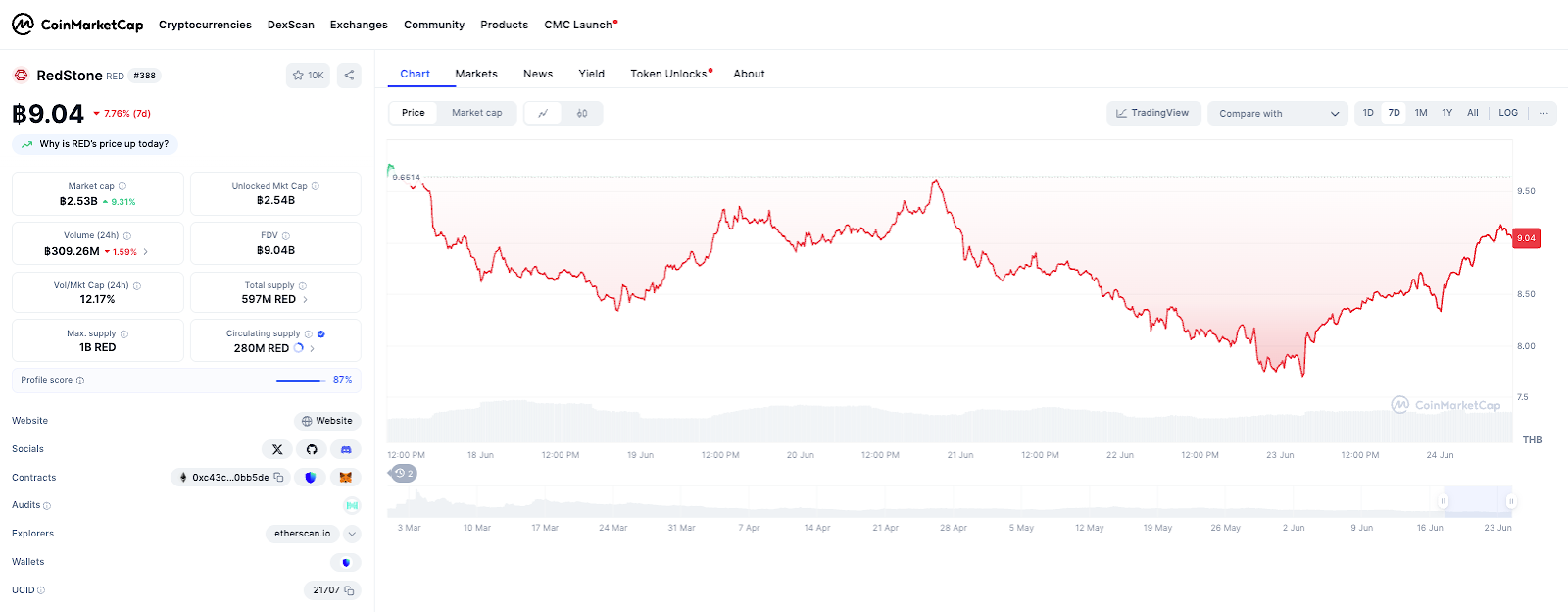
According to data from the Coinmarketcap website on June 24, 2025, the RED coin has a market cap of $77,344,418.3 USD or 2,531,512,703.26 Thai Baht.
At the time of writing this article, the RED coin is trading at a price of approximately $0.2762 or about 9.04 Baht per 1 RED. RED reached an all-time high price of $1.46 or approximately 47.68 Baht per 1 RED on March 3, 2025.
Reference: redstone docs, iqwiki Marcin, redstone finance
— — — — — — — — — — — — — — — — —

Disclaimer:
— Cryptocurrency and digital tokens involve high risks; investors may lose all investment money and should study information carefully and make investments according to their own risk profile.
— Past Returns does not guarantee future returns/performance.
ที่มา:
Medium